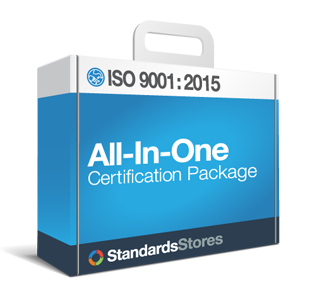ISO 9001 Processes, Procedures and Work Instructions
ISO 9001:2015 has relaxed the strict requirement for quality management documentation. However, in order to satisfy the remaining documentation requirements and to properly implement the Quality Management System (QMS), ISO 9001 Processes, Procedures and Work Instructions are typically still employed.
Section 4.4 of the standard, titled Quality Management System and its Processes covers the general requirements for work processes. Unfortunately, within the QMS planning and documentation realm, the terms are often confused. Below you’ll find definitions of each of these terms with examples and links to resources to help you improve creation of your ISO 9001:2015 documentation.
Learn More: How to Meet QMS Documentation Requirements
The Relationship Between Processes, Procedures and Work Instructions
When a company documents its QMS, it is an effective practice to clearly and concisely identify their processes, procedures and work instructions in order to explain and control how it meets the requirements of ISO 9001:2015. This begins with a basic understanding of the hierarchy of these terms and how to efficiently categorize the workings of a management system within them. Simply put:
A process states what needs to be done and why.
A procedure states how the process needs to be done.
A work instruction explains how to carry out the procedure.
Consider a process as a high level, strategic method of control, in effect a summary of objectives, specifications, and broad resources needed. The procedure adds more specifics such as responsibilities, specific tools, methods, and measurement. And a work instruction is a step-by-step guideline to implement the process and procedure, often segmented in some way to focus those who are doing the actual work.
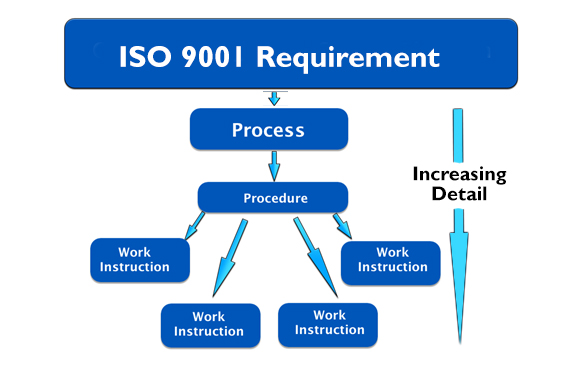
To control the outcome of a quality management system, more increasingly detailed action levels are often created in the form of processes, procedures and work instructions. These are typically to help satisfy a requirement by the quality management standard such as ISO 9001-2015.
The ISO 9001 Process, Procedure and Work Instruction Hierarchy
Some basic guidelines for remembering the differences between these terms when documenting your quality management system:
- Begin with the ISO 9001 processes you are required to document. The number of processes will typically determine the number of procedures. While the situation dictates the exact number of procedures needed to adequately control the desired outcome, it is a good organizational practice to not create more procedures than requirements.
- In most cases, you will create an ISO 9001 procedure for every process. Many companies write too many procedures when, in fact, they should be documenting these directives as more specific work instructions.
- When appropriate, create detailed ISO 9001 work instructions for each task that is needed to support each of your procedures. (A good rule of thumb is: if the procedure does not give enough guidance for someone to complete the task, create a work instruction.)
Product: Documentation Templates
Process
A process is any activity or set of activities that use resources to transform inputs into outputs. The ISO 9001 standard is based on a process approach. (Establishing effective and efficient processes that are consistently followed and improved upon is the basis for most management standards.)
Processes must have defined (and hopefully measurable) objective(s), input(s), output(s), activities, and resources. These key elements should be present when defining a process:
- Inputs/Resources:
- Specified requirements (needs), for example:
- What information do you need to start work?
- Where does that information come from?
- Specified requirements (needs), for example:
- Activities:
- Interrelated or interacting activities that use resources needed to achieve a specific output
- All of the operations, activities, and sub-processes carried out to produce the desired result, for example:
- What are the basic jobs carried out in your department?
- Can you explain to me your operations here?
- Outputs:
- Satisfying requirements (results), for example:
- Who receives the result of your work?
- How do you know if you’ve done your job correctly? (met objectives)
- Satisfying requirements (results), for example:
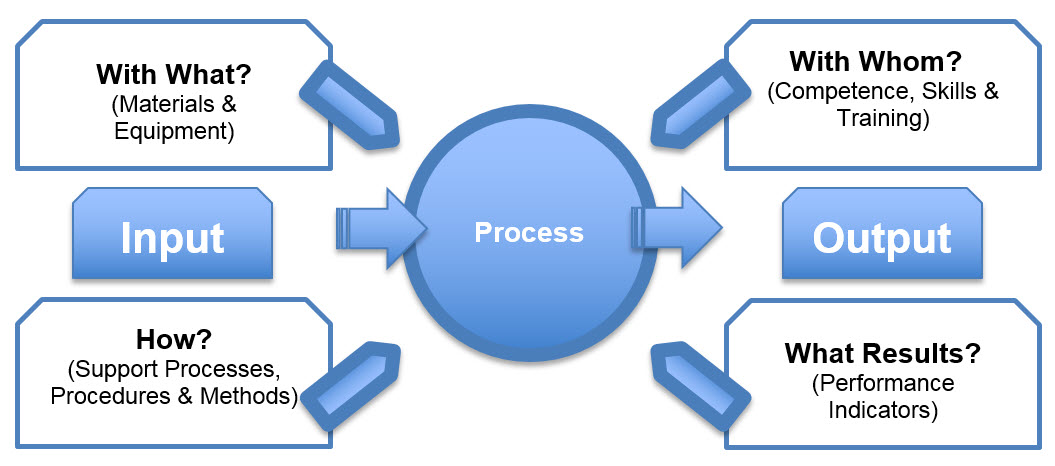
One way to visualize a process is as a trans-formative “machine” into which both requirements and resources are fed. The work is done and then received as a satisfactory result. The effectiveness of the process is measured in its ability to achieve the desired results. The efficiency of the process is measured in the ratio of results achieved to the resources used.
The ISO 9001 2015 standard suggests that many types of processes may be necessary to satisfy its requirements including:
- Operations management processes
- Resource management processes
- Planning processes
- Documentation processes (such as those used for direct production or service provision)
One of the main intents (and results) of employing well-constructed processes is to unify the working of the organization across vertical functions (also called “silos”). These may not always have the end goal of customer satisfaction as an internal priority. By exposing and documenting specific end-to-end process interaction, a higher order result can be achieved by proper management techniques (i.e. training, measurement, incentives/rewards, etc.)

Process Example: Hiring a Contractor The process for hiring a contractor might start with a request to hire a contractor (input), research into selecting the best contractor to hire (gathering information about capabilities and collecting quotes), and signing an initial check to perform a job (output).
Procedure
A procedure is a uniform method that outlines how to perform a process, such as how you control your suppliers. It typically contains elements such as:
- Why the procedure is required
- What needs to be accomplished and how it will be executed
- Who performs what action
- Where the inputs come from and where the outputs go
- Any locational requirements (i.e. where an activity is performed)
- The criteria (requirements) they must meet
- Tools, information or other resources required
- Terminology, definitions, explanations, etc.
While requirements and supporting processes are often cited in the ISO 9001:2015 standard, the mandate for creating specific procedures has been removed and replaced with the term “Documented information” (Learn more about Section 7.5: Documented Information). However, that does not lessen the need for, or effectiveness of, formally specifying procedures. Procedures are used when there is a definite operation that should be followed on a consistent basis. (There may be times when a procedure is not necessary. For example, if it doesn’t matter how new employees are recruited, just that there is a means for doing so, then a process could be written for that without a procedure.)

Procedure Example: Contract Review An example procedure is one that might be important for mission-critical, high liability industries like aerospace, medical devices or automotive could outline a formal process used for communicating with customers and reviewing information from the customer, including customer feedback. Click the above illustration for an example of how this type of procedure might be constructed using one of our procedure templates.
For example, procedures (along with your ISO 9001 quality manual and required forms) often make up the core documentation for the QMS that helps run the system with more conformity, consistency and, predictability. Your procedures will describe how you operate and control your business and meet the ISO 9001 requirements amid fluctuating conditions such as personnel changes, supplier replacements, updated customer requirements/expectations, etc. (The 9000 Store provides a complete set of the required ISO 9001 procedures that can be used as a guideline in drafting your specific procedures, an example of which is noted below.)

Click to view a Procedure Sample.
A procedure offers a general description of how a company meets a process requirement but doesn’t include the company-specific details for execution. These specific directives an employee needs to carry out company tasks are work instructions (see below).
Work Instruction
A work instruction describes how to perform a task within a process, which is a more detailed portion of the procedure such as “Completing a PO” or “Ordering supplies.” The reasons for work instructions are both organizational and explanatory:
- There are times more detail is needed than that which is described in the procedures. Many organizations include work instructions to detail specific tasks referenced in a procedure, aid in training and to reduce mistakes since the step-by-step instructions needed for accomplishing something may be missing from more generally drafted procedures.
- However, this functional division between procedure and work instruction can be a good organizational tool – if there is an advantage to dividing up procedure(s) into many “sub-procedures” that are related but cover different aspects.
A work instruction will often repeat many of the elements of a procedure to help describe where it fits into the process such as:
- Purpose
- Definitions
- Responsibility
- Requirements
- Tools and information
But at its core, a work instruction contains the step-by-step detail that is not advantageous to put into a procedure because it requires such a limited scope.
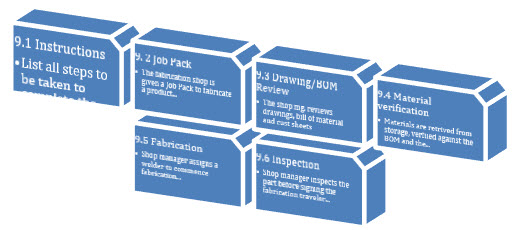
Work Instruction Example: Fabrication A welding-based fabrication assembly set of work instructions might contain step-by-step instructions for completing a final fabrication including cutting, drilling, and welding the finished part including inspection, inventory management, etc. Click on the above drawing for an example of how to construct a work instruction using one of our templates.
As noted above, there is no ISO 9001:2015 mandate for creating work instructions. However, years of quality management documentation practice suggests coupling these in the documentation hierarchy can more clearly and effectively control quality management outcomes.
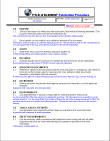
Click to view a Work Instruction Sample.
Product: All-in-One Certification Package
This is our most popular product and includes Manual, Procedures, Forms, Flowcharts, Checklists, Training, and more!
Please note that certain text from the ISO 9001 standard is only used for instructional purposes. Standard Stores recognizes and respects the International Organization for Standardization (ISO) copyright and intellectual property guidelines.
Gap Analysis Service
A consultant can save you time by performing a gap analysis for you. They are well versed in all of the ISO 9001:2015 requirements, and will help you focus in on the areas of your organization that need improvement to achieve certification. (Remote Analysis also available.)


